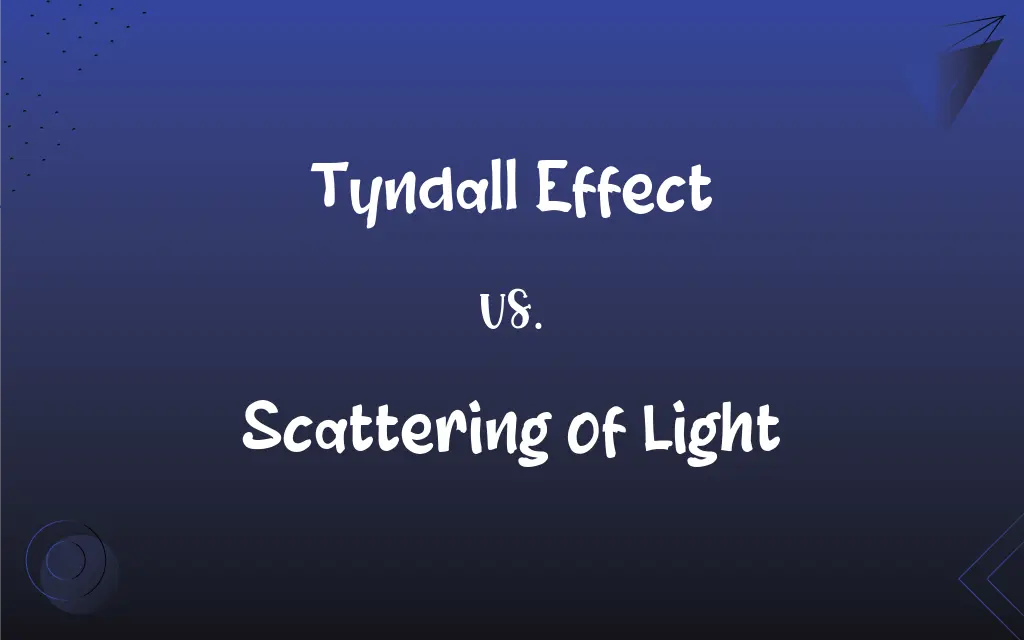Tyndall Effect vs. Scattering of Light: What's the Difference?
Edited by Aimie Carlson || By Janet White || Published on May 1, 2024
The Tyndall effect is the scattering of light by particles in a colloid or fine suspension, making the light path visible, while light scattering is a broader phenomenon where light is deflected by particles, molecules, or imperfections in a medium.

Key Differences
The Tyndall effect specifically refers to the scattering of light by particles in a colloid or a suspension, which are large enough to scatter light but not large enough to settle out of the mixture. This effect makes the path of a beam of light visible through a medium, such as when sunlight passes through mist. In contrast, scattering of light is a general term that encompasses any situation where light deviates from a straight trajectory due to interaction with particles, molecules, or imperfections in any medium, including gases, liquids, and solids.
The Tyndall effect is observed in colloidal dispersions or fine suspensions where particles scatter light, making the light beam visible, light scattering occurs in various contexts, including Rayleigh scattering by molecules in the atmosphere, which is responsible for the blue color of the sky. The Tyndall effect is a subset of light scattering phenomena, demonstrating how particle size and medium composition influence light's behavior.
The Tyndall effect can be used to distinguish between true solutions and colloidal suspensions, as true solutions do not scatter light visibly, whereas colloidal particles do. On the other hand, scattering of light includes a range of phenomena from the blue of the sky to the red of the sunset, governed by the size of the scattering particles relative to the wavelength of light.
Observation of the Tyndall effect requires a specific condition where the diameter of the dispersed particles is close to the wavelength of the light used, allowing for visible detection of the scattered light. Conversely, scattering of light can be influenced by various factors including particle size, light wavelength, and the medium's refractive index, encompassing a broader range of physical conditions and effects.
The Tyndall effect has practical applications in determining particle size and the stability of colloids, while light scattering techniques are utilized in scientific research, including atmospheric studies, astrophysics, and material science, highlighting their importance in understanding and manipulating light in various domains.
ADVERTISEMENT
Comparison Chart
Definition
Scattering of light by particles in a colloid, making the beam visible.
General phenomenon where light is deflected by particles or imperfections.
Cause
Particles within a specific size range in colloids or suspensions.
Any particles, molecules, or imperfections in a medium.
Visibility
Visible path of light in colloidal dispersions.
Can vary from invisible to visible depending on conditions.
Applications
Used to distinguish between true solutions and colloids.
Broad applications including atmospheric science, astrophysics.
Particle Size Relation
Particle size close to the wavelength of visible light.
Can involve particles smaller or larger than light's wavelength.
ADVERTISEMENT
Tyndall Effect and Scattering of Light Definitions
Tyndall Effect
Light scattering in colloids, revealing the path through the medium.
Laser pointers demonstrate the Tyndall effect in foggy conditions.
Scattering of Light
A principle used in analytical techniques to study material properties.
Light scattering techniques are crucial for characterizing nanoparticles.
Tyndall Effect
A phenomenon where colloidal particles make a light path visible.
Observing the Tyndall effect helps differentiate a colloid from a solution.
Scattering of Light
A broad phenomenon affecting light's trajectory through various mediums.
Scattering of light in a prism reveals the spectrum of visible light.
Tyndall Effect
A diagnostic tool for the presence of colloidal particles in a medium.
Scientists use the Tyndall effect to study particle size in aerosols.
Scattering of Light
Light's redirection due to interactions with molecules, particles, or surfaces.
The scattering of light on a cloudy day diffuses sunlight, reducing shadows.
Tyndall Effect
Visibility of light beams due to scattering by particles of a certain size.
The blue light of a smartphone's flashlight shows the Tyndall effect in mist.
Scattering of Light
The deflection of light rays by particles or imperfections in a medium.
Scattering of light by air molecules makes the sky appear blue.
Tyndall Effect
The visible scattering of light by particles in a colloidal suspension.
The Tyndall effect is why a beam of sunlight is visible when it enters a dusty room.
Scattering of Light
Influence on light path by size, shape, and composition of particles in a medium.
The scattering of light in the ocean depths causes the water to look deep blue.
FAQs
How does light scattering differ from the Tyndall effect?
Light scattering is a broader term, encompassing any deflection of light, while the Tyndall effect specifically refers to the scattering by colloidal particles.
What causes the Tyndall effect?
The Tyndall effect is caused by the scattering of light by particles in a colloidal suspension.
Is the Tyndall effect applicable in everyday life?
Yes, it can be observed in phenomena like the visibility of headlight beams in fog.
What is the significance of light scattering in atmospheric science?
Light scattering explains phenomena like blue skies and red sunsets, aiding in atmospheric composition studies.
How does particle size relate to the Tyndall effect?
The Tyndall effect is most pronounced when particle sizes are close to the light's wavelength.
What factors affect light scattering?
Light scattering is influenced by the particle size, light wavelength, and the medium's refractive index.
Can the Tyndall effect be used in scientific research?
Yes, it helps in studying particle size and the stability of colloidal suspensions.
What role does scattering of light play in optical instruments?
It's crucial in devices like microscopes and telescopes for enhancing image clarity and detail.
Is the Tyndall effect relevant to medical diagnostics?
Yes, it can be used in techniques like laser eye surgery and studying blood flow.
What is Rayleigh scattering?
A type of light scattering by particles smaller than the wavelength of light, explaining the blue sky.
Can the Tyndall effect be observed in all colloids?
The Tyndall effect is most noticeable in colloids with particle sizes similar to the wavelength of visible light.
Can the Tyndall effect be used to purify water?
While not a purification method, observing the Tyndall effect can indicate colloidal impurities in water.
How does the Tyndall effect contribute to the color of colloidal metals?
Colloidal metals scatter light, producing vibrant colors through the Tyndall effect.
Why is the sky blue?
The sky appears blue due to Rayleigh scattering, a type of light scattering by small molecules in the atmosphere.
What is Mie scattering?
Mie scattering is light scattering by particles about the same size as the light's wavelength, relevant in cloud and mist visibility.
How does water vapor affect light scattering?
Water vapor can enhance light scattering, contributing to phenomena like rainbows.
How do clouds affect light scattering?
Clouds scatter light in all directions, leading to the diffuse lighting on overcast days.
Can scattering of light be used to study the universe?
Yes, astronomers use light scattering to study the composition and movement of celestial bodies.
Can the Tyndall effect be harmful?
Generally, it's not harmful but can indicate air pollution when observed in the atmosphere.
What are practical applications of light scattering?
It's used in technologies ranging from atmospheric pollution monitoring to enhancing photographic and cinematic visuals.
About Author
Written by
Janet WhiteJanet White has been an esteemed writer and blogger for Difference Wiki. Holding a Master's degree in Science and Medical Journalism from the prestigious Boston University, she has consistently demonstrated her expertise and passion for her field. When she's not immersed in her work, Janet relishes her time exercising, delving into a good book, and cherishing moments with friends and family.
Edited by
Aimie CarlsonAimie Carlson, holding a master's degree in English literature, is a fervent English language enthusiast. She lends her writing talents to Difference Wiki, a prominent website that specializes in comparisons, offering readers insightful analyses that both captivate and inform.






































































